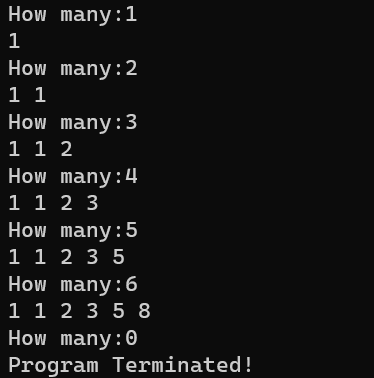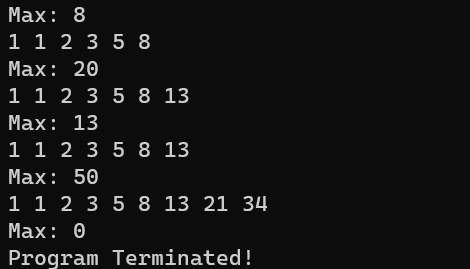斐波那契数列的C语言实现
斐波那契数列
经典数学问题之一;斐波那契数列,又称黄金分割数列,指的是这样一个数列:
1、1、2、3、5、8、13、21、……
前两个数为1, 1,之后每个数都为为前面两个数的相加。
C语言实现:
输出斐波那契数列前n个数字:
1、普通算法
#include <stdio.h>
int test2(void); int main(void) { while(1) { int flag = test2(); if(flag != 1) break; } return 0; } int test2(void) { int t1 = 1, t2 = 1, n, next, i; printf("How many:"); scanf("%d", &n); if(n <= 0) { printf("Program Terminated!\n"); return -1; } for(i = 1; i <= n; i++) { printf("%d ", t1); next = t1 + t2; t1 = t2; t2 = next; } printf("\n"); return 1; }
2、递归实现
#include <stdio.h>
int test3(int);
int test5(void);
int main(void)
{
while(1)
{
int flag = test5();
if(flag != 1) break;
}
return 0;
}
/* 使用递归方式 */
int test3(int index)
{
if(index == 1 || index == 2) return 1;
return (test3(index -1) + test3(index -2));
}
int test5(void)
{
int i, n;
printf("How many:");
scanf("%d", &n);
if(n <= 0)
{
printf("Program Terminated!\n");
return -1;
}
for(i = 1; i <= n; i++)
{
printf("%d ", test4(i));
}
printf("\n");
return 1;
}
运行结果:

用递归的方法实现此数列简洁,方便理解。但是我们仔细观察上面的代码,就会发现此函数中存在着大量的冗余计算,并且n越大,冗余的越多。
输出数列中小于等于Max的数字
#include <stdio.h>
int test6(void);
int main(void)
{
while(1)
{
int flag = test6();
if(flag != 1) break;
}
return 0;
}
int test6(void)
{
int t1 =1, t2 = 1, next, Max;
printf("Max: ");
scanf("%d", &Max);
if(Max <= 0)
{
printf("Program Terminated!\n");
return -1;
}
while(t1 <= Max)
{
printf("%d ", t1);
next = t1 + t2;
t1 = t2;
t2 = next;
}
printf("\n");
return 1;
}
运行结果:

新人才疏学浅,有错的地方敬请指正!!
本文来自博客园,作者:夏末终年,转载请注明出处:https://www.cnblogs.com/xiamozhongnian/p/15861331.html







